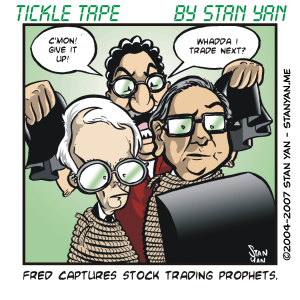To some extent, fundamentals drive prices, but in the end, the price of a stock or commodity is largely a matter of opinion. Opinions consist of “soft” data, data that is messy, flimsy, and difficult to get a handle on. That’s where psychology comes in. At times, trading can be 100% psychology. It’s a matter of measuring people’s beliefs, and unfortunately, there are times where it is almost impossible to get an accurate measurement and to know exactly what is going to happen next. It’s just like the presidential election. For weeks, pollsters were unable to get an accurate read, and they just didn’t know what was going to happen.
Trading is a lot like working as a pollster. You are trying to gauge popular opinion and guess what people are going to do next. There are times when getting an accurate read on the markets is hard. When measuring human behavior, the error is substantial. At best, one can merely make a probabilistic statement based on a few key assumptions. It’s hard to measure an opinion.
And even if someone holds a particular opinion, he or she may not act on it. For example, in an election, when one candidate is clearly the leader in an opinion poll, a pollster can make a good guess as to the winner. But in a close race, pollsters have no idea. They don’t know who will show up on Election Day, for example. There’s a lot of uncertainty that can’t be pinned down. The outcome is too close to call. A similar comparison can be made to the bull market of the late 1990s.
Prices were going up with little resistance. The opinion was clear and strong. In such a case, it was easy to measure and forecast the opinion of the masses. And many traders, professionals and amateurs, made huge profits. There are some market conditions where trading is straightforward. A clear trend emerges and you can trade it. There are other times when you just can’t make a profit. A talent all traders must hone is the ability to intuitively assess what the masses are going to do, and when you have a strong feeling for what will happen next, you can capitalize on it.
It is useful to remember that it is difficult to measure human behavior. Social scientists have discovered that people do not respond consistently. And if social scientists can’t measure people’s behavior with relatively accurate, and if people don’t seem to respond consistently, how can we expect to measure the behavior of market participants precisely? Why should we assume that people would react consistently to particular market conditions (and thus, form the price patterns outlined in classic technical analysis texts)? We probably can’t make the assumption. Sure, there’s some consistency.
But it is nothing like the consistency we are used to in the physical world. Our estimates are merely best guesses, and potentially inaccurate ones. So when you are trying to anticipate what the masses of market participants will do, remember that humans are not like rising and falling tides (Dow Theory may suggest that they behave with such regularity, but it is just a theory, not a law). They are not nearly as predictable as that. When studying human behavior, and that’s what you’re doing as a trader, there is no such thing as certainty. It’s all just a matter of probabilities. And that means no one will ever know what will happen in the markets next.


